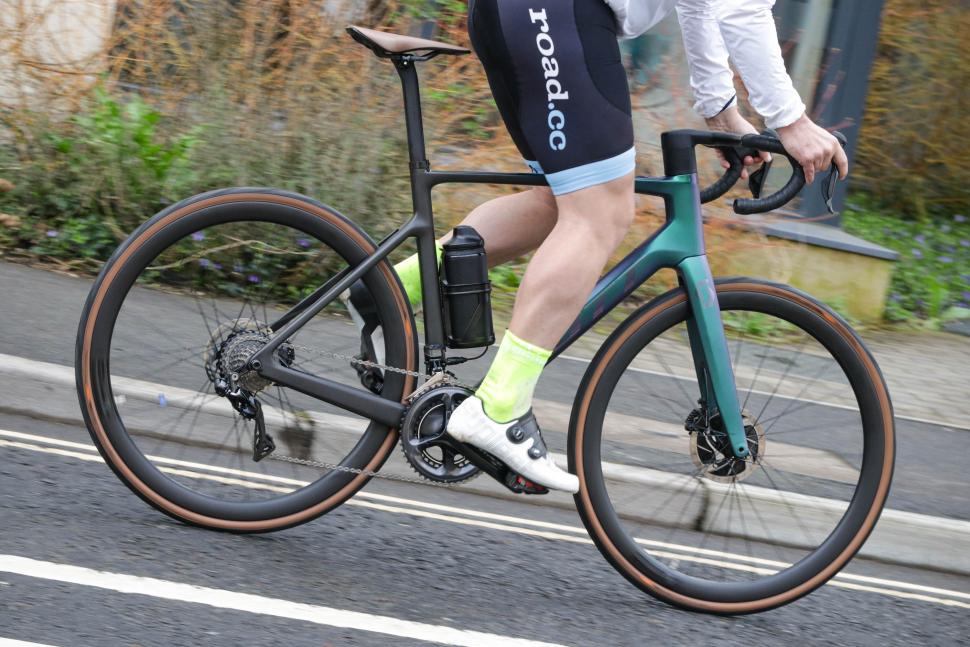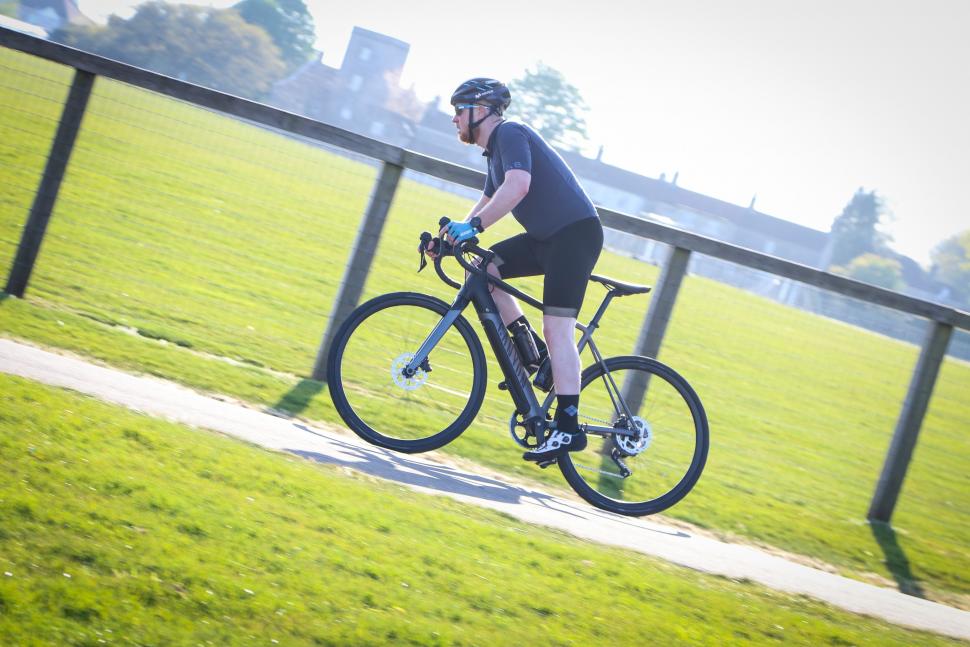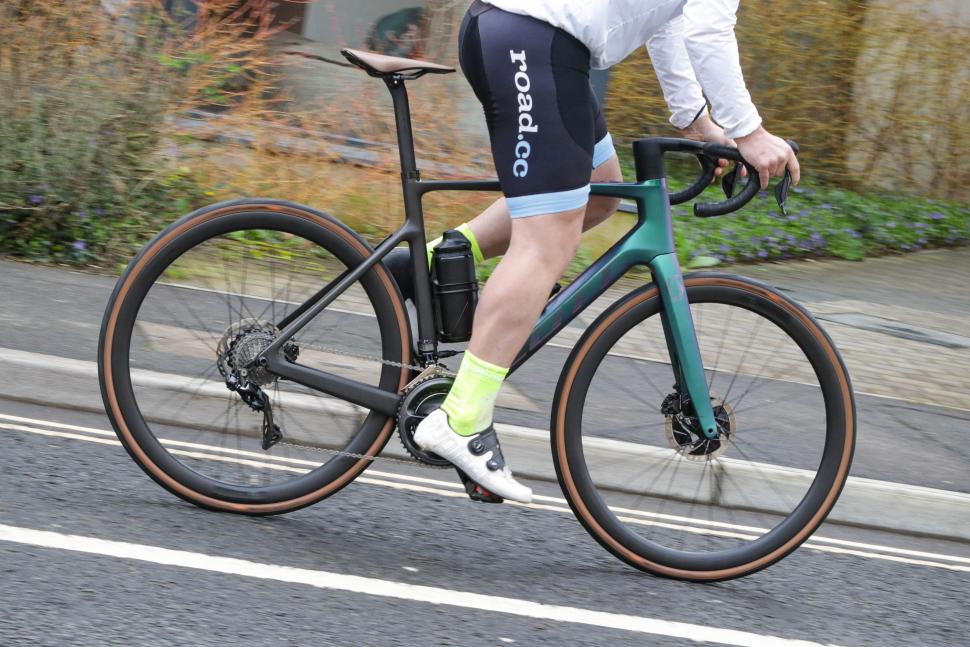- News
- Reviews
- Bikes
- Accessories
- Accessories - misc
- Computer mounts
- Bags
- Bar ends
- Bike bags & cases
- Bottle cages
- Bottles
- Cameras
- Car racks
- Child seats
- Computers
- Glasses
- GPS units
- Helmets
- Lights - front
- Lights - rear
- Lights - sets
- Locks
- Mirrors
- Mudguards
- Racks
- Pumps & CO2 inflators
- Puncture kits
- Reflectives
- Smart watches
- Stands and racks
- Trailers
- Clothing
- Components
- Bar tape & grips
- Bottom brackets
- Brake & gear cables
- Brake & STI levers
- Brake pads & spares
- Brakes
- Cassettes & freewheels
- Chains
- Chainsets & chainrings
- Derailleurs - front
- Derailleurs - rear
- Forks
- Gear levers & shifters
- Groupsets
- Handlebars & extensions
- Headsets
- Hubs
- Inner tubes
- Pedals
- Quick releases & skewers
- Saddles
- Seatposts
- Stems
- Wheels
- Tyres
- Health, fitness and nutrition
- Tools and workshop
- Miscellaneous
- Tubeless valves
- Buyers Guides
- Features
- Forum
- Recommends
- Podcast
 2021 Scott Addict eRoad - riding 3.jpg
2021 Scott Addict eRoad - riding 3.jpgHow to use an e-bike to improve your fitness
Riding an electric bike isn’t just a question of sitting there and letting the motor do the work – you still have to put the effort in, so not only can you reach new places on rides, you can also reach new heights with your fitness. Here’s how…

If fitness is your goal, why not just buy a non-electric bike and start racking up the miles? That would be simple enough in many cases, but a lot of people buy an e-bike because it suits their needs in other ways – it allows them to get to work in a reasonable amount of time, for example, or to cover more ground than would otherwise be possible – they just want to use it for getting fit too.
Also, with an e-bike there are different levels of electric assistance to help you out when the road ramps up. Knowing it's there for when you really need it and using the assist at certain places in your rides can help you make fitness gains at other points.
You can use an e-bike in conjunction with a heart rate monitor to see what you’re inputting and a power meter to see what you’re outputting. Basically, you can still track how hard you push and how much fitness progress you’re making when riding an e-bike.
Here are some ways an e-bike can be used for fitness gains and why it can be beneficial for many people to ride one for getting stronger and faster, and for having an absolute blast with mates in new places.
For this expert advice, we spoke to Level 3 ABCC accredited coach Liam Holohan of Holohan Coaching.
- Latest reviews of e-bikes
- 18 of the best 2021 electric road bikes — get powered aid on the sly
-
11 of the best e-bikes for around £1,000 2021: Electric bikes on a budget
An e-bike opens up new and longer rides
E-bikes can open up a whole new area to explore on rides because you can get further as hills don’t zap your legs so quickly on the way.
It’s not just intensity in rides that allows you to get fitter, upping the ride duration can result in significant aerobic benefits.
> Discovering cycling in your 40s - how to unlock the talents you never knew you had
Getting fit is fun when you’re exploring somewhere new while building up your endurance —riding to new places can be motivating. You can reach a new café to try out or arrive fresher at the bottom of a famous climb for which you plan to turn off your assist.
“An e-bike can help you ride a route that otherwise you wouldn’t currently be able to accomplish under your own steam," Liam says.
“It’s also motivating to ride somewhere new. You can get sick of just riding around your local area. E-bikes open up more of the world to people.”
Mapping apps like Komoot can help you plan your next adventure with its route features and multi-day planner. If you’re interested in keeping track of riding territory you’ve conquered so you know which places you’ve yet to explore, Strava’s personal heatmap is a helpful and inspiring tool.
> 8 things you didn’t know about Strava — advanced features for exploring and performance analysis
More riding buddies equals more fun...

It’s not often that you’ll be at exactly the same fitness level as your friend or partner, but with one of you using an e-bike this can mean it’s possible to ride together. Having a mate to roam about with can help you improve your fitness level because you'll be more likely to ride further and more frequently.
“If you want to ride with your partner [or friend] and you’ve got differences in fitness abilities, using an e-bike opens up riding with those who are fitter than you,” Liam says.
“It could compensate for those differences in physiological variables between the sexes or a trained female could ride with a less trained man—it’s sort of a leveller.”
As well as enjoying the ride with a buddy, having a commitment with someone in particular (rather than a group ride where your individual absence is less missed) can guarantee you’ll end up going on the ride. The most effective way of improving your fitness level is to get out on your bike, so anything that helps with that is absolutely great.
Making use of your commute
Going to and from work can take out a significant portion of your day and so using this time can be an efficient way of getting in some steady miles regularly to build your fitness.
> How to get the most from your limited training time
“You may not want to ride to work and arrive really sweaty and worn out before the working day ahead of you,” Liam notes.
> Best casual cycling commuter wear – check out our buyer’s guide
“Using an e-bike means you don’t have to get out of breath on the hills on the way to work so you’re more likely to commute.”
> 10 cycle commuting mistakes and how to avoid them
With an e-bike you’d also be able to choose the hillier but more scenic roads to work. If it’s a pleasant route you’re more likely to continue to commute by bike on a regular basis as it’s something you enjoy (as well as time-efficient and cost-effective too, of course).
> 30 of the best cycle commuting upgrades and accessories
If you are in the routine of commuting you’re also less likely to cut down on it when you’re pushing through a busier period, unlike a standalone ride planned for the evening. A commute gets your exercise packed in first thing before the rest of life takes over for the day.
Using your commute effectively
E-bikes can also help you tailor your two different commuting rides—the ride into work and the return leg—to achieve different training benefits.
“There’s good evidence supporting two-a-day training sessions,” says Liam. “With one of those sessions you should be fuelled and well-rested for, and this would typically be your high-intensity session.
“Whereas the second session may be more of a steady-state ride to get in some different endurance training adaptations.
“You could use an e-bike to control the intensity in that second ride so you’re not pushing too hard and compromising your subsequent training sessions should you live in a hilly area where it’s just not possible to stick to those lower training zones,” Liam explains.
Enables you to develop your skills

Part of being able to improve your fitness is having the handling skills to be able to push the pedals harder and go faster while staying in control.
> 11 tips for better cornering — get round bends faster
E-bikes can allow you to work on technical aspects of your cycling performance on easier days.
“You can go and work on your downhill skills without having to ride up, say, a 15% gradient to get to the top of the hill,” Liam notes.
> Video: Top tips for better descending - How to become faster and safer going downhill
“It opens up another skill session that you wouldn’t otherwise be able to do without compromising your training plan.”
An e-bike allows you to go easy when it’s best to
To improve your fitness it’s important to go hard. But to go hard again and again, you also need to take it easy at times. E-bikes can help with going easier when it’s appropriate to do so.
If you’ve got a specific target for that ride, you can take it easy, have an effective progressive warm-up before the effort, instead of tiring yourself out. For example, you may want to improve your time up a 5-minute climb, but there are some killer steep slopes on the 20km ride to it. Here an e-bike can help you arrive fresher so you’re ready to deliver your best shot up that specific climb and smash that PB.
It's the same when you're doing interval training. If you’ve got hard 1-2 minute efforts planned at 5-minute intervals throughout your ride, for example, after just completing a full gas effort the last thing your legs need is a steep slope as you desperately try to recover for the next.
It’s very difficult to plan a route that has uphills and downhills that sync with your planned session. An e-bike can allow you to recover more effectively in between efforts so you can work hard when you really need to and see fitness gains.
Go on proper active recovery rides
Getting stronger and fitter is not just about smashing it on the bike. To optimise your body’s adaptation process you need to think about recovery too. To complete your upcoming training session effectively you need to have recovered from the previous workout. Active recovery rides are incredibly useful for spinning out the legs and stretching out the muscles that are feeling still and sore, but it’s very important you complete these at the required intensity.
In the UK, there are no mountains, but there are hills everywhere, and by everywhere I mean everywhere but Norfolk! It’s very difficult to stick to an appropriate recovery pace as soon as you hit a hill. It should be easy enough so you can have a conversation up the climb without getting out of breath. This is where an e-bike can come in handy; you can get outside into the fresh air and stay in the easy zone to recover.
For more recovery tips check out our full guide over here.
E-bikes are great for joining group rides
“One of the reasons we ride bikes is for the social element–for chatting to friends and the café stop rides," says Liam.
“But you may feel a bit anxious about going on group rides, especially your first one. Riders may be thinking: what if I get dropped? What if I can’t keep up on the hills?”
“An e-bike removes that barrier. It can be your safety net.”
Group rides can be a fun, social way of getting fitter and the regulars will likely have lots of experience and so can help you improve your fitness with their advice.
Aim higher, push yourself
It can be daunting attacking climbs early on in a bike ride as you could be worried you’ll be crawling home later on.
An e-bike can give you the confce to go harder as you know you’ll be able to make it up that dreaded last hill – that one that always feels like it’s steeper than you remember.
An e-bike can also give you the confidence to set yourself challenges or goals that you might have otherwise decided against. In the moment it’s easier to dig deeper to get through it and so if an ebike can help you set off, then that’s great for pushing your limits and getting stronger.
E-bikes allow you to ease back after injury or illness
If you’re returning to the bike after some time off, particularly after injury or illness, an e-bike can help you gradually transition back into riding again. You can knock back the intensity where the terrain wouldn’t typically allow you to.
Indoor riding on turbo trainers can also help you moderate your effort, but it’s just not the same as being able to go outside into the fresh air, into the beautiful countryside.
> 12 of the best smart home trainers for 2021 — get fit indoors
“An e-bike can be very beneficial because the last thing you want to do when coming back from an illness or injury is to push too much too soon because that’s another two weeks or another month off the bike,” notes Liam.
High torque, low cadence efforts up tough climbs can cause knee problems and so ebikes can help reduce the risk of aggravating an injury. This is of particular importance for 40+-year-olds as your ligaments and joints have already started to decondition so it’s important to protect them as much as you can.
> How to maximise your fitness when you get to 40+
Checking up on your riding position with a bike fit also helps prevent injury. Quite simply, avoiding injury means more on the bike time and more opportunity to get fitter.
Anna has been hooked on bikes ever since her youthful beginnings at Hillingdon Cycle Circuit. As an avid road and track racer, she reached the heady heights of a ProCyclingStats profile before leaving for university. Having now completed an MA in Multimedia Journalism, she’s hoping to add some (more successful) results. Although her greatest wish is for the broader acceptance of wearing funky cycling socks over the top of leg warmers.
Latest Comments
- HoarseMann 2 sec ago
wot no radar? good job they're on a black friday special at the mo...
- newbankgyratory 9 min 59 sec ago
I reckon the residents should be given some more options:...
- Bungle_52 11 min 21 sec ago
Tweak no 1 then. The tag would need to beep at around 15mph getting more frequent as it approaches 20. It would come with an advisory note to...
- AidanR 32 min 16 sec ago
Sorry, but I have little sympathy for Wiggins. Per the latest set of accounts (2018), by far the biggest asset was a director's loan to Wiggins. In...
- mark1a 1 hour 1 min ago
That will be along in a week or so in the annual reboot of the "All I want for Christmas is... not this" article along with the Park Tool pizza...
- quiff 1 hour 13 min ago
For that money, I'd go to Matthew Sowter - https://www.saffronframeworks.com/
- hawkinspeter 1 hour 20 min ago
The problem with most jeans (i.e. not cycling designed ones) is that they've got the seam where it can intefere/chafe with the saddle. Also, cotton...
- hawkinspeter 1 hour 24 min ago
Why do the police have to wait for the council to install CCTV cameras? Can't they go and put one there themselves - it doesn't even have to be a...
- mdavidford 1 hour 52 min ago
I'm not sure commercial success is even particularly high on his list of priorities for it - it's much more about the leverage it gives him for...
- the little onion 5 hours 9 min ago
Rather artistic photo of this (driverless) car that has ended up on its roof on a dead straight road in Bradford....


Add new comment
35 comments
Well said Cap'n.
They are fun. I do 35km/h on the flat which feels great. My 750W motor could go a lot faster but I choose not to.
- be great if I could still walk. After riding non assisted bikes for over 60 years I feel I'm now entitled to use all the help I can get.
Brian Robinson rides an ebike. He's still out there doing it.
Need I say more ...
What if you want to get to work and not be a sweaty mess? What if you don't have time to walk up hills? What if you have groceries or child? I rarely ride mine anymore but I don't judge people who do. They have different lives.
Pages